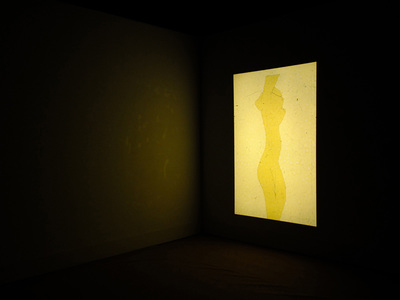CAVALEIRO BRANCO
(WHITE KNIGHT)
Museu Geológico
Lisbon, December 2015
Specifications:
160 slides, 2 projectors, acetate, chromatic filter, acetate pens,
coloured pencils, tracing paper, adhesive film, cardboard.
Variable dimension.
(WHITE KNIGHT)
Museu Geológico
Lisbon, December 2015
Specifications:
160 slides, 2 projectors, acetate, chromatic filter, acetate pens,
coloured pencils, tracing paper, adhesive film, cardboard.
Variable dimension.
|
Luísa Metelo Seixas – Cavaleiro Branco presents a set of images that articulate with one another, in an archive of shapes that contaminate and influence each other. They seem to create magnetic fields that take us from one shape to the next. How do these images appear?
Bernardo Simões Correia – These images come from things that I see, of ideas, of sounds and conversations, of other images, of sketches that start to happen and then transform into something else. In truth they come from everywhere. LMS – How do you perceive the drawing in these set of images? BSC –Drawing is a constant practice that sometimes is more constant than others. Usually it appears in a selfless and uncommited way in a time or in a space that wouldn’t have been dedicated to it in the first place. Sometimes they are revisited and in some of them new things are understood or unraveled that makes taking them off the sketchbook and into the acetate worthwhile. There starts a new stage of drawing, cutting and pasting that ends in a revelation through the light that shines through them. LMS – There seems to be a discovery with each image, that makes us think the drawing and the shape simultaneously, in a very immediate sense – as perhaps the botos-montanhas in Tigre,– that arises from a certain unpreperdness for that encounter. How does Cavaleiro Branco relate to this idea? BSC – Cavaleiro Branco (White Knight) is one of the names of Lancelot of the Lake, the best and bravest knight of King Arthur’s round table. But it is also who, for love, betrays his King, never getting to accomplish his quest for the holy grail because he is only allowed a few blurred visions of the chalice and never the opportunity to touch it. On the other hand, the Cavaleiro Branco, is also the old confused knight-inventor that always lands on his head but that ends up, in his half foolish kind of way, rescuing Alice from Lewis Caroll’s book. There is a wandering common quality in these kights that is not sensless and where there is a welcoming of the unexpected, an attention to the apparitions. LMS – This unreadiness is announced with quite a sense of humour, specially when simpler, even childish, shapes appear, but in their whole create a strange surprise. The shames, the smiles, appear frequently in your drawings. How do you understand that humour in your practice? BSC – It seems to me that humour is more of a laugh by one who has had a happy encounter than mere entertainment or cynicism. It’s a sort of redemptive enjoyment LMS – The sequences, the repetition of almost identical shapes, that vary in dimension and colour, have been frequent in your work. You mention a search, a quest, that seems more present in this exhibition. How does Cavaleiro Branco relate to this idea? BSC – The search is done by doing it. It’s like a hunter that wanders the forest chasing an animal he never reaches, and if by chance he gets to touch him he disappears and the chase continues. It’s a matter of faith , of belief. It’s about how you look and not what you’re looking for, because what we’re looking for is in fact always the same. Lisbon, December 2015 |
|












